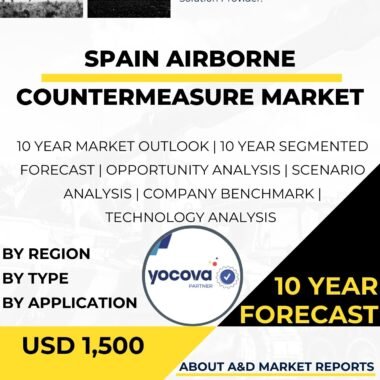Description
United Kingdom Airborne Countermeasure Market
The United Kingdom airborne countermeasure market the plays a critical role in enhancing the survivability of military aircraft and helicopters against various threats, including surface-to-air missiles, heat-seeking missiles, and radar-guided munitions. Airborne countermeasures are defensive systems designed to deceive or disrupt enemy targeting mechanisms, providing a vital layer of protection for aircraft operating in hostile environments. This article explores the current state of the UK airborne countermeasure market, examining the technologies involved, its applications, key players, challenges, and future growth prospects.
Airborne countermeasures encompass a range of technologies and tactics aimed at confusing or thwarting enemy targeting systems. One of the primary types of countermeasures is electronic warfare (EW), which includes electronic countermeasures (ECM) and electronic support measures (ESM). ECM involves emitting electronic signals to jam or deceive enemy radars and missiles, while ESM focuses on passive detection and analysis of enemy electronic emissions.
The United Kingdom’s military aircraft and helicopters are equipped with sophisticated EW suites that include chaff and flare dispensers, electronic jammers, and towed decoy systems. Chaff is small metallic strips released by the aircraft to create false radar returns, while flares divert incoming heat-seeking missiles away from the aircraft’s engines. Electronic jammers emit radiofrequency signals to disrupt or confuse enemy radar and communication systems, reducing the effectiveness of incoming threats.
The UK’s airborne countermeasure market is driven by the need to protect military assets during combat missions, peacekeeping operations, and humanitarian missions in high-threat environments. Airborne countermeasures are crucial for enhancing the survivability of aircraft and ensuring the safety of personnel during critical operations.
The Royal Air Force (RAF) and the British Army’s aviation units are significant users of airborne countermeasure systems. The RAF’s fast-jet aircraft, such as the Eurofighter Typhoon, and transport aircraft, like the Lockheed C-130 Hercules, are equipped with advanced EW suites to defend against a range of threats. Additionally, rotary-wing platforms, such as the Apache attack helicopter, use countermeasure systems to protect against shoulder-fired missiles and other aerial threats.
The UK airborne countermeasure market features a mix of domestic companies and international defense manufacturers. British firms play a vital role in the development and integration of EW systems into military platforms. International collaborations and partnerships with allied nations also contribute to technology sharing and innovation in the airborne countermeasure domain.
Challenges in the UK airborne countermeasure market revolve around the ever-evolving threat landscape. Adversaries continue to develop and deploy advanced missile technologies and sophisticated electronic warfare systems. The UK defense industry must continually invest in research and development to stay ahead of emerging threats and ensure the effectiveness of countermeasure systems.
Furthermore, the integration of EW systems with the rapidly advancing avionics and sensor technologies of modern aircraft poses technical challenges. Seamless compatibility, reliable performance, and minimal interference with the aircraft’s existing systems are crucial factors for successful airborne countermeasure integration.
Cost considerations are also significant challenges in the UK airborne countermeasure market. The development, production, and maintenance of advanced EW systems require substantial financial investments. Striking a balance between budget constraints and maintaining cutting-edge capabilities is an ongoing concern.
Looking ahead, the future prospects of the UK airborne countermeasure market are promising. Advancements in EW technologies, signal processing, and artificial intelligence will continue to improve countermeasure system performance and effectiveness. The integration of unmanned aerial vehicles (UAVs) into air defense and electronic warfare operations is also likely to create new opportunities for airborne countermeasure technologies.
As the threat landscape evolves, there is a growing emphasis on multi-spectral countermeasures that can address threats from multiple domains, such as radar, infrared, and laser-guided munitions. Integrating various countermeasure technologies into comprehensive EW suites will be crucial for maintaining a robust defense posture.
International collaborations and joint development programs will continue to play a vital role in shaping the UK airborne countermeasure market. Partnering with technologically advanced nations allows the UK to access cutting-edge technologies, share expertise, and address common challenges collectively.
In conclusion, the United Kingdom’s airborne countermeasure market is a crucial component of its defense industry, providing a vital layer of protection for military aircraft and helicopters. The deployment of advanced EW systems enhances the survivability of aircraft in hostile environments and ensures the safety of personnel during critical missions. Addressing challenges related to evolving threats, cost considerations, and technology integration requires continuous investment in research, innovation, and collaboration with international partners. Looking forward, advancements in EW technologies and international cooperation will play a pivotal role in shaping the future of the UK airborne countermeasure market, strengthening the nation’s air defense capabilities and contributing to its overall security posture.




